第四章 英语修辞格译法
- 格式:ppt
- 大小:354.50 KB
- 文档页数:33
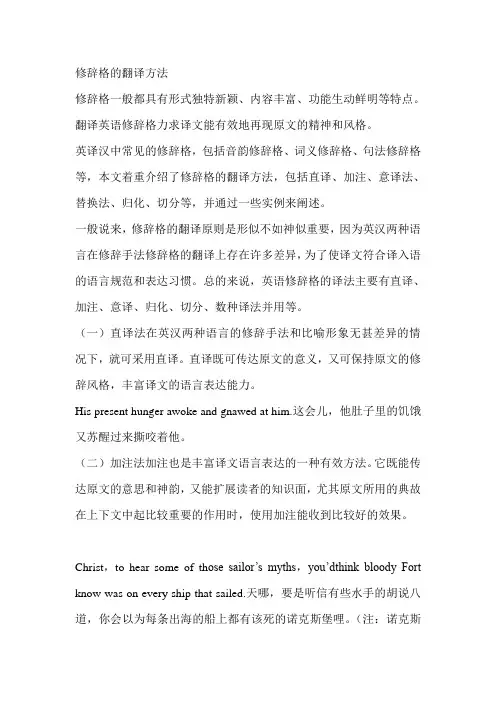
修辞格的翻译方法修辞格一般都具有形式独特新颖、内容丰富、功能生动鲜明等特点。
翻译英语修辞格力求译文能有效地再现原文的精神和风格。
英译汉中常见的修辞格,包括音韵修辞格、词义修辞格、句法修辞格等,本文着重介绍了修辞格的翻译方法,包括直译、加注、意译法、替换法、归化、切分等,并通过一些实例来阐述。
一般说来,修辞格的翻译原则是形似不如神似重要,因为英汉两种语言在修辞手法修辞格的翻译上存在许多差异,为了使译文符合译入语的语言规范和表达习惯。
总的来说,英语修辞格的译法主要有直译、加注、意译、归化、切分、数种译法并用等。
(一)直译法在英汉两种语言的修辞手法和比喻形象无甚差异的情况下,就可采用直译。
直译既可传达原文的意义,又可保持原文的修辞风格,丰富译文的语言表达能力。
His present hunger awoke and gnawed at him.这会儿,他肚子里的饥饿又苏醒过来撕咬着他。
(二)加注法加注也是丰富译文语言表达的一种有效方法。
它既能传达原文的意思和神韵,又能扩展读者的知识面,尤其原文所用的典故在上下文中起比较重要的作用时,使用加注能收到比较好的效果。
Christ,to hear some of th ose sailor’s myths,you’dthink bloody Fort know was on every ship that sailed.天哪,要是听信有些水手的胡说八道,你会以为每条出海的船上都有该死的诺克斯堡哩。
(注:诺克斯堡是美国一个军事保留地,是美国黄金仓库的所在地。
)(三)意译法由于许多英语修辞手法或比喻形象本身是特有的,如保留其形象就会危害其义。
如英语的头韵法,其搭配可以千变万化,很难碰巧找到这样的汉语搭配,即使勉强凑韵,也不一定能表达原文的意思。
在这种情况下,必须首先保证译文能正确传达原文的思想内容,然后尽一切可能去表现原文的节奏和旋律。
safe and sound安然无恙now and never机不可失(1)He is the mouth of the House in its relations with the crown.他是议会对王室的发言人。


荆楚理工学院《翻译理论与实践》教学大纲一、课程名称:翻译理论与实践二、课程代码:三、课程管理:外国语学院(部)英语本科教研室四、教学对象:09级英语(本科)专业五、教学时数:总时数72节,其中课堂讲授36节,教学实践36节。
六、课程性质:专业、必修、基础课七、教学目的与要求:(一)教学目的《翻译理论与实践》课的教学目的是让学生初步了解有关翻译的基础理论知识,系统讲解基本的翻译方法和技巧,指导翻译实践,把学生掌握的语言知识和技能技巧转化为翻译表达能力。
通过反复实践加强翻译基本功,深化对英汉文化的领悟,提高学生的百科知识、文化再现能力、译文对比分析和鉴赏能力。
(二)教学要求1.课堂教学要求:在理论知识讲授的同时,辅以充分、典型的译例分析,通过活跃的课堂师生互动,把枯燥的理论课变得成生动活泼、妙趣横生而受学生喜欢。
分不同文体选择适量单、长句练习和语篇练习,口头翻译课课做,书面实践周周做,练习反馈时时做。
实行课后作业全批、全改、全讲解,有针对性检查指导学生实际翻译实践活动。
2.学生能力培养的要求:掌握基本的翻译理论知识,能较熟练地运用各种翻译技巧,利用文体分析法分析和识别汉英两种语言在遣词造句、文体文化等方面的差异,初步进行忠实通顺的英汉互译实践。
从而能在毕业以后能较快适应在政治、经济、文化等领域的工作,在各行各业的英汉翻译中发挥积极的作用,以更好满足社会主义市场经济对翻译人才的要求。
八、相关课程衔接:《语法》、《英汉文化对比》等九、考核方式:笔试十、教学纲目:第一章绪论一、教学目标:通过本章的学习,让学生了解中西翻译理论简史,明确翻译的定义和翻译的目的,熟悉翻译标准和译者的素质与条件。
二、教学重点及难点:教学重点:纠正学生认为翻译就是一一对应的英汉转换和翻译课就是死板枯燥的理论教授的错误观念,使其认识到翻译是一种文化交流。
教学难点:介绍翻译的标准和译者的素质与条件,使学生改变翻译课枯燥难学的观念,同时感受到翻译的乐趣。
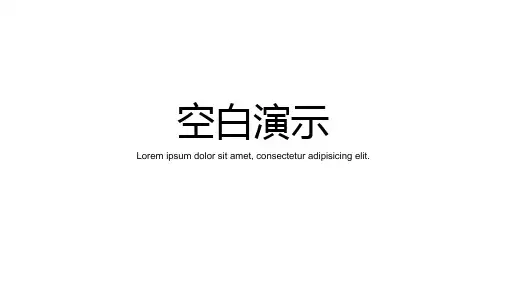

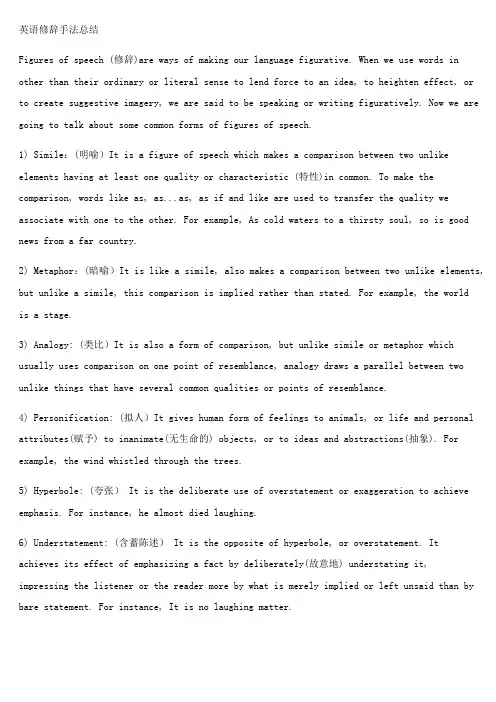
英语修辞手法总结Figures of speech (修辞)are ways of making our language figurative. When we use words in other than their ordinary or literal sense to lend force to an idea, to heighten effect, orto create suggestive imagery, we are said to be speaking or writing figuratively. Now we are going to talk about some common forms of figures of speech.1) Simile:(明喻)It is a figure of speech which makes a comparison between two unlike elements having at least one quality or characteristic (特性)in common. To make the comparison, words like as, as...as, as if and like are used to transfer the quality we associate with one to the other. For example, As cold waters to a thirsty soul, so is good news from a far country.2) Metaphor:(暗喻)It is like a simile, also makes a comparison between two unlike elements, but unlike a simile, this comparison is implied rather than stated. For example, the worldis a stage.3) Analogy: (类比)It is also a form of comparison, but unlike simile or metaphor which usually uses comparison on one point of resemblance, analogy draws a parallel between two unlike things that have several common qualities or points of resemblance.4) Personification: (拟人)It gives human form of feelings to animals, or life and personal attributes(赋予) to inanimate(无生命的) objects, or to ideas and abstractions(抽象). For example, the wind whistled through the trees.5) Hyperbole: (夸张) It is the deliberate use of overstatement or exaggeration to achieve emphasis. For instance, he almost died laughing.6) Understatement: (含蓄陈述) It is the opposite of hyperbole, or overstatement. Itachieves its effect of emphasizing a fact by deliberately(故意地) understating it,impressing the listener or the reader more by what is merely implied or left unsaid than by bare statement. For instance, It is no laughing matter.7) Euphemism: (委婉) It is the substitution of an agreeable or inoffensive(无冒犯) expression for one that may offend or suggest something unpleasant. For instance, we refer to "die" as " pass away".8) Metonymy (转喻)It is a figure of speech that has to do with the substitution of the mane of one thing for that of another. For instance, the pen (words) is mightier than the sword (forces).9) Synecdoche (提喻) It is involves the substitution of the part for the whole, or thewhole for the part. For instance, they say there's bread and work for all. She was dressedin silks.10) Antonomasia (换喻)It has also to do with substitution. It is not often mentioned now, though it is still in frequent use. For example, Solomon for a wise man. Daniel for a wise and fair judge. Judas for a traitor.11) Pun: (双关语) It is a play on words, or rather a play on the form and meaning of words. For instance, a cannon-ball took off his legs, so he laid down his arms. (Here "arms" has two meanings: a person's body; weapons carried by a soldier.)12) Syllepsis: (一语双叙) It has two connotations.In the first case, it is a figure by which a word, or a particular form or inflection of a word, refers to two or more words in the same sentence, while properly applying to or agreeing with only on of them in grammar or syntax(句法). For example, He addressed you and me, and desired us to follow him. (Here us is used to refer to you and me.)In the second case, it a word may refer to two or more words in the same sentence. For example, while he was fighting , and losing limb and mind, and dying, others stayed behind to pursue education and career. (Here to losing one's limbs in literal; to lose one's mindis figurative, and means to go mad.)13) Zeugma: (轭式搭配) It is a single word which is made to modify or to govern two or more words in the same sentence, wither properly applying in sense to only one of them, orapplying to them in different senses. For example, The sun shall not burn you by day, nor the moon by night. (Here noon is not strong enough to burn)14) Irony: (反语) It is a figure of speech that achieves emphasis by saying the opposite of what is meant, the intended meaning of the words being the opposite of their usual sense. For instance, we are lucky, what you said makes me feel real good.15) Innuendo: (暗讽) It is a mild form of irony, hinting in a rather roundabout (曲折)way at something disparaging(不一致) or uncomplimentary(不赞美) to the person or subject mentioned. For example, the weatherman said it would be worm. He must take his readings in a bathroom.16) Sarcasm: (讽刺) It Sarcasm is a strong form of irony. It attacks in a taunting and bitter manner, and its aim is to disparage, ridicule and wound the feelings of the subject attacked. For example, laws are like cobwebs, which may catch small flies, but let wasps break through.17) Paradox: (似非而是的隽语) It is a figure of speech consisting of a statement or proposition which on the face of it seems self-contradictory, absurd or contrary to established fact or practice, but which on further thinking and study may prove to be true, well-founded, and even to contain a succinct point. For example more haste, less speed.18) Oxymoron: (矛盾修饰) It is a compressed paradox, formed by the conjoining(结合) of two contrasting, contradictory or incongruous(不协调) terms as in bitter-sweet memories, orderly chaos(混乱) and proud humility(侮辱).19) Antithesis: (对照) It is the deliberate arrangement of contrasting words or ideas in balanced structural forms to achieve emphasis. For example, speech is silver; silence is golden.20) Epigram: (警句) It states a simple truth pithily(有利地) and pungently(强烈地). It is usually terse and arouses interest and surprise by its deep insight into certain aspects of human behavior or feeling. For instance, Few, save the poor, feel for the poor.21) Climax: (渐进) It is derived from the Greek word for "ladder" and implies the progression of thought at a uniform or almost uniform rate of significance or intensity,like the steps of a ladder ascending evenly. For example, I came, I saw, I conquered.22) Anti-climax or bathos: (突降)It is the opposite of Climax. It involves stating one's thoughts in a descending order of significance or intensity, from strong to weak, from weighty to light or frivolous. For instance, But thousands die, without or this or that, die, and endow(赋予) a college, or a cat.23) Apostrophe: (顿呼) In this figure of speech, a thing, place, idea or person (dead or absent) is addressed as if present, listening and understanding what is being said. For instance, England! awake! awake! awake!24) Transferred Epithet: (转类形容词) It is a figure of speech where an epithet (anadjective or descriptive phrase) is transferred from the noun it should rightly modify(修饰) to another to which it does not really apply or belong. For instance, I spent sleeplessnights on my project.25) Alliteration: (头韵) It has to do with the sound rather than the sense of words for effect. It is a device that repeats the same sound at frequent intervals(间隔) and since the sound repeated is usually the initial consonant sound, it is also called "front rhyme". For instance, the fair breeze blew, the white foam flew, the furrow followed free.26) Onomatopoeia: (拟声) It is a device that uses words which imitate the sounds made by an object (animate or inanimate), or which are associated with or suggestive(提示的) of some action or movementExplanation version1一、什么是修辞格修辞格(figures of speech)是提高语言表达效果的语言艺术。
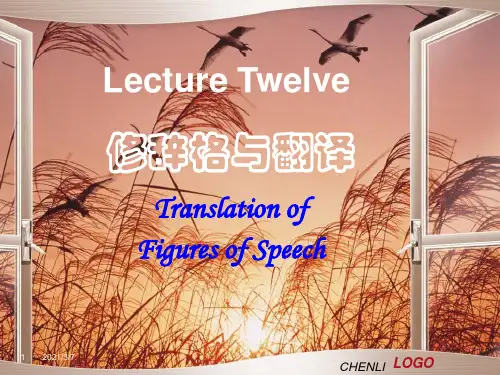

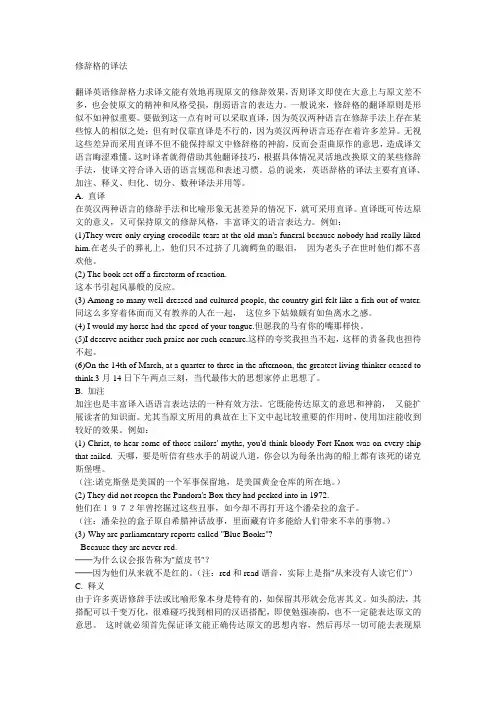
修辞格的译法翻译英语修辞格力求译文能有效地再现原文的修辞效果,否则译文即使在大意上与原文差不多,也会使原文的精神和风格受损,削弱语言的表达力。
一般说来,修辞格的翻译原则是形似不如神似重要。
要做到这一点有时可以采取直译,因为英汉两种语言在修辞手法上存在某些惊人的相似之处;但有时仅靠直译是不行的,因为英汉两种语言还存在着许多差异。
无视这些差异而采用直译不但不能保持原文中修辞格的神韵,反而会歪曲原作的意思,造成译文语言晦涩难懂。
这时译者就得借助其他翻译技巧,根据具体情况灵活地改换原文的某些修辞手法,使译文符合译入语的语言规范和表述习惯。
总的说来,英语辞格的译法主要有直译、加注、释义、归化、切分、数种译法并用等。
A. 直译在英汉两种语言的修辞手法和比喻形象无甚差异的情况下,就可采用直译。
直译既可传达原文的意义,又可保持原文的修辞风格,丰富译文的语言表达力。
例如:(1)They were only crying crocodile tears at the old man's funeral because nobody had really liked him.在老头子的葬礼上,他们只不过挤了几滴鳄鱼的眼泪,因为老头子在世时他们都不喜欢他。
(2) The book set off a firestorm of reaction.这本书引起风暴般的反应。
(3) Among so many well-dressed and cultured people, the country girl felt like a fish out of water. 同这么多穿着体面而又有教养的人在一起,这位乡下姑娘颇有如鱼离水之感。
(4) I would my horse had the speed of your tongue.但愿我的马有你的嘴那样快。
(5)I deserve neither such praise nor such censure.这样的夸奖我担当不起,这样的责备我也担待不起。
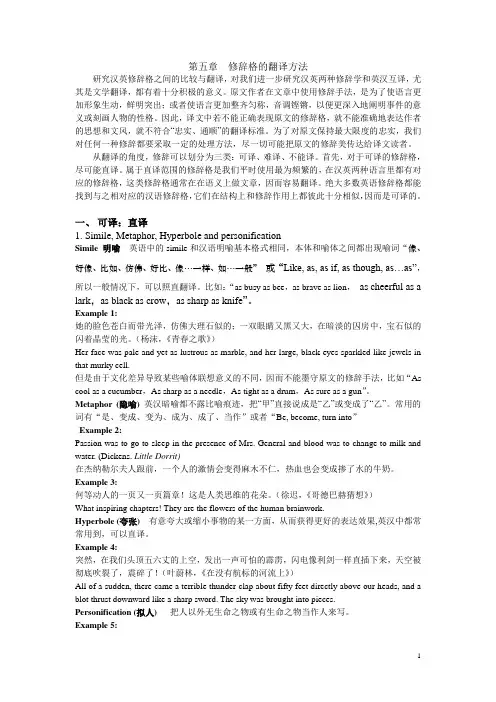
第五章修辞格的翻译方法研究汉英修辞格之间的比较与翻译,对我们进一步研究汉英两种修辞学和英汉互译,尤其是文学翻译,都有着十分积极的意义。
原文作者在文章中使用修辞手法,是为了使语言更加形象生动,鲜明突出;或者使语言更加整齐匀称,音调铿锵,以便更深入地阐明事件的意义或刻画人物的性格。
因此,译文中若不能正确表现原文的修辞格,就不能准确地表达作者的思想和文风,就不符合“忠实、通顺”的翻译标准。
为了对原文保持最大限度的忠实,我们对任何一种修辞都要采取一定的处理方法,尽一切可能把原文的修辞美传达给译文读者。
从翻译的角度,修辞可以划分为三类:可译、难译、不能译。
首先,对于可译的修辞格,尽可能直译。
属于直译范围的修辞格是我们平时使用最为频繁的,在汉英两种语言里都有对应的修辞格,这类修辞格通常在在语义上做文章,因而容易翻译。
绝大多数英语修辞格都能找到与之相对应的汉语修辞格,它们在结构上和修辞作用上都彼此十分相似,因而是可译的。
一、可译:直译1. Simile, Metaphor, Hyperbole and personificationSimile 明喻英语中的simile和汉语明喻基本格式相同,本体和喻体之间都出现喻词“像、好像、比如、仿佛、好比、像…一样、如…一般”或“Like, as, as if, as though, as…as”,所以一般情况下,可以照直翻译。
比如:“as busy as bee,as brave as lion,as cheerful as alark,as black as crow,as sharp as knife”。
Example 1:她的脸色苍白而带光泽,仿佛大理石似的;一双眼睛又黑又大,在暗淡的囚房中,宝石似的闪着晶莹的光。
(杨沫,《青春之歌》)Her face was pale and yet as lustrous as marble, and her large, black eyes sparkled like jewels in that murky cell.但是由于文化差异导致某些喻体联想意义的不同,因而不能墨守原文的修辞手法,比如“As cool as a cucumber,As sharp as a needle,As tight as a drum,As sure as a gun”。
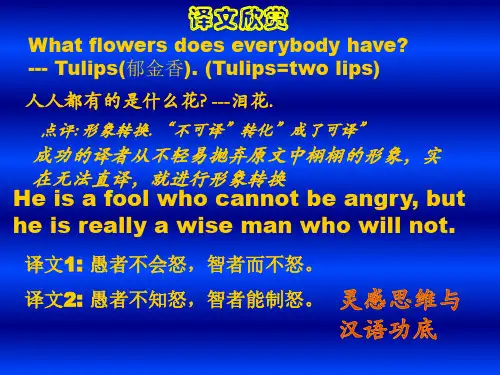
英语修辞手法总结Figures of speech (修辞)are ways of making our language figurative. When we use words in other than their ordinary or literal sense to lend force to an idea, to heighten effect, orto create suggestive imagery, we are said to be speaking or writing figuratively. Now we are going to talk about some common forms of figures of speech.1) Simile:(明喻)It is a figure of speech which makes a comparison between two unlike elements having at least one quality or characteristic (特性)in common. To make the comparison, words like as, as...as, as if and like are used to transfer the quality we associate with one to the other. For example, As cold waters to a thirsty soul, so is good news from a far country.2) Metaphor:(暗喻)It is like a simile, also makes a comparison between two unlike elements, but unlike a simile, this comparison is implied rather than stated. For example, the worldis a stage.3) Analogy: (类比)It is also a form of comparison, but unlike simile or metaphor which usually uses comparison on one point of resemblance, analogy draws a parallel between two unlike things that have several common qualities or points of resemblance.4) Personification: (拟人)It gives human form of feelings to animals, or life and personal attributes(赋予) to inanimate(无生命的) objects, or to ideas and abstractions(抽象). For example, the wind whistled through the trees.5) Hyperbole: (夸张) It is the deliberate use of overstatement or exaggeration to achieve emphasis. For instance, he almost died laughing.6) Understatement: (含蓄陈述) It is the opposite of hyperbole, or overstatement. Itachieves its effect of emphasizing a fact by deliberately(故意地) understating it,impressing the listener or the reader more by what is merely implied or left unsaid than by bare statement. For instance, It is no laughing matter.7) Euphemism: (委婉) It is the substitution of an agreeable or inoffensive(无冒犯) expression for one that may offend or suggest something unpleasant. For instance, we refer to "die" as " pass away".8) Metonymy (转喻)It is a figure of speech that has to do with the substitution of the mane of one thing for that of another. For instance, the pen (words) is mightier than the sword (forces).9) Synecdoche (提喻) It is involves the substitution of the part for the whole, or thewhole for the part. For instance, they say there's bread and work for all. She was dressedin silks.10) Antonomasia (换喻)It has also to do with substitution. It is not often mentioned now, though it is still in frequent use. For example, Solomon for a wise man. Daniel for a wise and fair judge. Judas for a traitor.11) Pun: (双关语) It is a play on words, or rather a play on the form and meaning of words. For instance, a cannon-ball took off his legs, so he laid down his arms. (Here "arms" has two meanings: a person's body; weapons carried by a soldier.)12) Syllepsis: (一语双叙) It has two connotations.In the first case, it is a figure by which a word, or a particular form or inflection of a word, refers to two or more words in the same sentence, while properly applying to or agreeing with only on of them in grammar or syntax(句法). For example, He addressed you and me, and desired us to follow him. (Here us is used to refer to you and me.)In the second case, it a word may refer to two or more words in the same sentence. For example, while he was fighting , and losing limb and mind, and dying, others stayed behind to pursue education and career. (Here to losing one's limbs in literal; to lose one's mindis figurative, and means to go mad.)13) Zeugma: (轭式搭配) It is a single word which is made to modify or to govern two or more words in the same sentence, wither properly applying in sense to only one of them, orapplying to them in different senses. For example, The sun shall not burn you by day, nor the moon by night. (Here noon is not strong enough to burn)14) Irony: (反语) It is a figure of speech that achieves emphasis by saying the opposite of what is meant, the intended meaning of the words being the opposite of their usual sense. For instance, we are lucky, what you said makes me feel real good.15) Innuendo: (暗讽) It is a mild form of irony, hinting in a rather roundabout (曲折)way at something disparaging(不一致) or uncomplimentary(不赞美) to the person or subject mentioned. For example, the weatherman said it would be worm. He must take his readings in a bathroom.16) Sarcasm: (讽刺) It Sarcasm is a strong form of irony. It attacks in a taunting and bitter manner, and its aim is to disparage, ridicule and wound the feelings of the subject attacked. For example, laws are like cobwebs, which may catch small flies, but let wasps break through.17) Paradox: (似非而是的隽语) It is a figure of speech consisting of a statement or proposition which on the face of it seems self-contradictory, absurd or contrary to established fact or practice, but which on further thinking and study may prove to be true, well-founded, and even to contain a succinct point. For example more haste, less speed.18) Oxymoron: (矛盾修饰) It is a compressed paradox, formed by the conjoining(结合) of two contrasting, contradictory or incongruous(不协调) terms as in bitter-sweet memories, orderly chaos(混乱) and proud humility(侮辱).19) Antithesis: (对照) It is the deliberate arrangement of contrasting words or ideas in balanced structural forms to achieve emphasis. For example, speech is silver; silence is golden.20) Epigram: (警句) It states a simple truth pithily(有利地) and pungently(强烈地). It is usually terse and arouses interest and surprise by its deep insight into certain aspects of human behavior or feeling. For instance, Few, save the poor, feel for the poor.21) Climax: (渐进) It is derived from the Greek word for "ladder" and implies the progression of thought at a uniform or almost uniform rate of significance or intensity,like the steps of a ladder ascending evenly. For example, I came, I saw, I conquered.22) Anti-climax or bathos: (突降)It is the opposite of Climax. It involves stating one's thoughts in a descending order of significance or intensity, from strong to weak, from weighty to light or frivolous. For instance, But thousands die, without or this or that, die, and endow(赋予) a college, or a cat.23) Apostrophe: (顿呼) In this figure of speech, a thing, place, idea or person (dead or absent) is addressed as if present, listening and understanding what is being said. For instance, England! awake! awake! awake!24) Transferred Epithet: (转类形容词) It is a figure of speech where an epithet (anadjective or descriptive phrase) is transferred from the noun it should rightly modify(修饰) to another to which it does not really apply or belong. For instance, I spent sleeplessnights on my project.25) Alliteration: (头韵) It has to do with the sound rather than the sense of words for effect. It is a device that repeats the same sound at frequent intervals(间隔) and since the sound repeated is usually the initial consonant sound, it is also called "front rhyme". For instance, the fair breeze blew, the white foam flew, the furrow followed free.26) Onomatopoeia: (拟声) It is a device that uses words which imitate the sounds made by an object (animate or inanimate), or which are associated with or suggestive(提示的) of some action or movementExplanation version1一、什么是修辞格修辞格(figures of speech)是提高语言表达效果的语言艺术。
英语常用语义修辞格的翻译英、汉两种语言在语义方面都有大量的修辞方式。
这两种语言中经常运用形象性手段来加强语言效果,从而达到修辞目的。
而这种比喻性手段在两种语言中的表达方式上与形象性的比喻上,有的相同,有的不尽相同。
有的形象性用法能为一种语言的读者有所了解、接受,而对另一种语言的读者则显得陌生或不能接受。
因此,在翻译英语语义修辞格时,不仅要注意形式上的对应,更应注意符合汉语的表达习惯。
本文拟讨论英语常用的语义修辞格的翻译。
一、明喻(simile)在翻译英语的明喻时,一般采用直译法,将其译成汉语的明喻。
但由于英汉两个民族的历史发展、生活环境、风俗习惯各不相同,思维方式和美学观念也有所差异,有的英语明喻和汉语明喻的比喻形象不尽相同。
因此,有时也用意译法、变通法和注释法。
如:He was like a cock who thought the sun hadrisen for him to crow. 他这人就像一只骄傲的公鸡,以为太阳升起是为了它的啼叫。
( simile →明喻。
直译法)Tom was as sober as a judge. 他十分清醒。
(simile →非修辞格。
意译法)He is as cunning as a dead pig. 他像狐狸一样狡猾。
(simile →明喻。
但不是“像死猪一样狡猾”。
变通法)Falstaff : I am as poor as Job , my lord , but not sopatient . 福斯塔夫: 我是像约伯(注) 一样穷的,大人,可是却没有他那样的好耐性。
(注:约伯(Job)《圣经》中的人物, 以忍耐贫穷而著称的圣徒。
)(simile →明喻。
但译文意义不清楚,故加了注释。
注释法)二、隐喻(metaphor)英语隐喻的翻译,一般采用修辞格转换法或直译法,将其译成汉语的明喻或隐喻。
但由于英汉两种文化的差异,有时需要转换表达或修辞方式、或改变喻体以符合汉语的习惯。